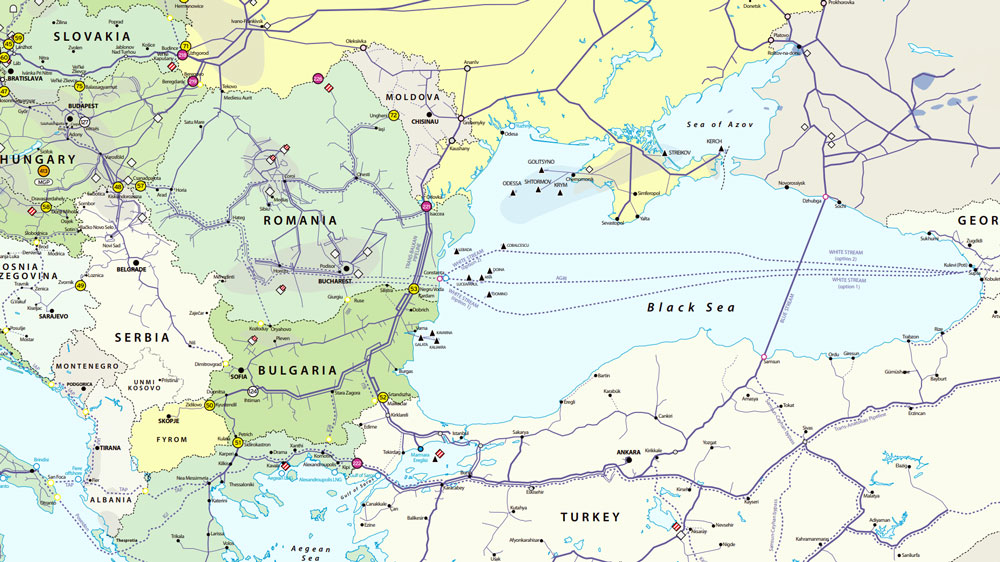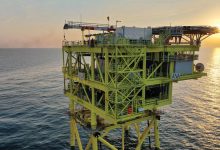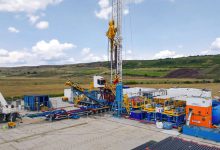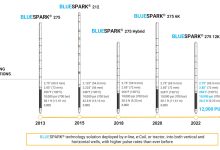Southern Gas Corridor project
New developments
In early 2018, Romania stated its desire to participate in one of the most important infrastructure projects for the European energy security. It’s about the Southern Gas Corridor project (SGC), which carries gas from the Caspian Sea to Europe via Azerbaijan, Georgia and Turkey, through the Trans-Anatolian Natural Gas Pipeline, and then via Greece, Albania and Italy through the Trans Adriatic Pipeline. This network of pipelines would ensure 20% of European Union’s demand.
The Southern Gas Corridor project aims to increase and diversify European energy supply by bringing gas resources from the Caspian Sea to markets in Europe. The Southern Gas Corridor comprises four projects: operation of Shah Deniz natural gas-condensate field (SD1) and its full-field development (SD2); the operation of the South Caucasus Pipeline (SCP) and its expansion (SCPX); the construction of the Trans-Anatolian Natural Gas Pipeline (TANAP) and the construction of the Trans Adriatic Pipeline (TAP). The projects have an estimated investment cost of approximately USD 40 billion. Upon completion, the SD2 project will add a further 16 bcm of natural gas per annum to 10.9 bcma (maximum production capacity) already produced under SD1 project. Total length of the newly constructed SCPX, TANAP and TAP pipelines will be around 3,206 kilometres.
TAP and TANAP: Getting ready to receive gas
Speaking at the European Gas Conference in Vienna (January 28 – 30), TAP Executive Director Luca Schieppati mentioned that more than 84 percent of the project, including engineering, procurement and construction, had been implemented to transport natural gas to Europe. He added that 97 percent of TAP pipes in Greece and Albania had already been defined. At the same time, Italy continues to work on construction of the terminal and micro-tunnel. Earlier, Schieppati said that TAP had completed its USD 4.5 billion (EUR 3.9 billion) project financing, paving the way for construction to be completed for start-up in 2020. TAP also marked the launch of offshore works mid-October 2018. Overall, offshore construction work is approximately 10% complete, as of end-November 2018.
“2018 was marked by a number of milestones. These included the successful installation of the turbo compressors in Greece and Albania, launching offshore construction works, completing the connection (otherwise known as the ‘golden weld’) with TANAP, completing one of the longest horizontal directional drilling to cross the Axios river in Greece and successfully installing the pipeline at the highest point of the project, 2,100 meters above sea level in the Albanian mountains”.
“Despite undertaking such technically challenging work, our safety performance remains world-class. So far, we have worked more than 37 million man-hours and driven over 100 million kilometres without any major accidents and with frequency rates (Lost Time Frequency rate and Total Recordable Frequency Rate) in line with best industry levels. TAP also received the OHSAS 18001, ISO 14001 and ISO 9001 certifications. These were awarded for our integrated quality, health, safety and environment (QHSE) management systems, reinforcing that TAP applies industry best practice, processes and procedures,” he added.
Also, in 2018, both the European Bank for Reconstruction and Development (EBRD) and the European Investment Bank (EIB) each approved loans of over EUR 1bn for TAP gas pipeline. The rest of the financing has come from export credit agencies and a group of 17 commercial banks, which include Bank of China, BNP Paribas, Société Générale and UniCredit.
With exit points along the route, TAP has the potential to support new gas infrastructure, integrate the markets of South-East Europe and strengthen the region’s strategic status as a source of energy. For example, TAP’s interconnectivity will form the basis of Albania’s gas market and connect the country to one of Europe’s most innovative and important infrastructure corridors. The pipeline will also make the delivery of energy to end-consumers more reliable and will contribute to a significant reduction in CO2 emissions, providing an alternative to more polluting energy sources, supporting the transition to low-carbon economies, in line with the new energy strategy assumed by the EBRD.
The TAP project, however, is subject to a series of environmental and political criticisms, as well as by local communities in Italy, who fear that this pipeline will discourage tourism in the southern area of Italy. However, in October 2018, Italian Prime Minister Giuseppe Conte gave his final approval for this project, which was vehemently disputed by the 5-star Movement (M5S, antisystem), which together with the League (the far right) formed the ruling coalition in Italy.
Gas supply to Turkey by TANAP to double in 2019
According to AzerNews, Azerbaijan plans to increase the volume of gas transportation via the Trans Anatolian Natural Gas Pipeline to 2 billion cubic meters in 2019, Public Relations Head at Azerbaijan’s state oil company SOCAR Ibrahim Ahmadov stated. Moreover, he noted that the overall progress in TANAP project is nearing 99 percent.
The volume of gas transportation through TANAP reached 1 billion cubic meters as of 2018.
A ceremony to launch TANAP took place June 12, 2018 in the Turkish city of Eskisehir.
The initial capacity of TANAP is expected to be 16 billion cubic meters of gas per year. About six billion cubic meters will be supplied to Turkey, and the rest to Europe.
About TAP
Trans Adriatic Pipeline (TAP), 870 km long, is the last section of this corridor, enabling natural gas transportation from Turkey to Italy, via Greece and Albania. In 2020, when the first gas deliveries to Europe are scheduled, TAP will be the first non-Russian gas pipeline to supply Europe, after the Medgaz connection that started delivering gas from Algeria to Spain in 2011.
About TANAP
With a length of 1850 km, the Trans-Anatolian Gas Pipeline (TANAP) connects the Turkish border to Greece and Georgia. The initial capacity of TANAP would be of 16 bcm per year and would increase up to 23 bcm in 2023 and 31 bcm in 2026. The company in charge of the TANAP project is 58% owned by the national oil company of Azerbaijan, SOCAR, and 30% by the Turkish petroleum company Botas.
Romania’s involvement
On 15 February 2018, Romania’s delegation, led by Iulian-Robert Tudorache, State Secretary within the Ministry of Energy, attended the Fourth Meeting of the Consultative Council of the Southern Corridor, held in Baku. Romania’s participation to this meeting is a first, thus marking a change of vision at the ministry level.
Romania has proposed the inclusion in the plans for the expansion of the Southern Gas Corridor of the infrastructure offered by BRUA project, together with the interconnector between Romania and Bulgaria, for the transmission of natural gas from the Southern Corridor, on the Romanian territory, to Central Europe. At the end of the meeting, Romania signed, with the other members, the text of the Ministerial Statement, in which, inter alia, Romania’s support for implementing the Southern Gas Corridor and its contribution to the connection of this project to Central Europe are recognized.
On May 29, 2018 Baku hosted the launch ceremony of the first phase of the Southern Gas Corridor project. The gas from the Azerbaijani Shah Deniz field has already gone through the first segment of the Southern Gas Corridor – from the Sangachal terminal to the expanded South Caucasus Pipeline.
BRUA background & updates
BRUA gas pipeline (Phase 1) will be completed on 31 December 2019 and will carry resources coming from the Caspian region through the Trans Adriatic Pipeline and through the vertical corridor, Ion Sterian, General Manager of Transgaz, stated on the occasion of Aspen Energy Summit in Ploiesti, held on 28 November 2018. At the time, Ion Sterian announced that the first gas compressor station, in Jupa, was to be completed a year earlier compared to the commissioning of the pipeline (31 December 2019). On 30 July 2019 the second compressor station will be completed, in Podisor, and in October 2019 – the third compressor station, in Bibesti.
The transmission capacity to Bulgaria will be 1.5 billion Scm/year, and that to Hungary – 1.75 billion Scm/year, upon completion of Phase 1 of the project; upon completion of Phase 2, the transmission capacity to Bulgaria – 1.5 billion Scm/year, and to Hungary – 4.4 billion Scm/year (according to the NTS development plan for 2018 – 2027). Completion of Phase 2 of the project is estimated for 2022. The total value of the investment amounts to EUR 547.4mln, broken down as follows: Phase 1 – EUR 478.6mln and Phase 2 – EUR 68.8mln.
Currently, only 40% of the capacity necessary for the construction of Phase 2 of the gas pipeline (which would take over Black Sea gas) is booked. For now, the economic tests are negative for both the Romanian gas transmission operator, Transgaz, and for the Hungarian TSO, FGSZ, part of MOL Group.
“If no one submits applications for booking additional capacity during 05.02.2019 – 25.02.2019, the binding open season procedure RO-HU ends without the allocation of transmission capacity and the prerequisites for building transmission capacity additional to the one ensured by building BRUA project Phase I are not created,” Transgaz representatives have mentioned.
The Director General of Transgaz has mentioned that the source of gas to be carried via BRUA (Phase 1) are the Caspian countries, Iran, Iraq and Kurdistan, gas which will arrive in Europe via TAP and further through the vertical corridor Greece-Bulgaria-Romania.
Bulgarian Government injects BGN 76.2M in Greece-Bulgaria gas interconnector
Bulgaria’s Cabinet approved on December 19, 2018 the allocation of BGN 76.2 million, or about EUR 39 million, in EU funds for the construction of the Greece-Bulgaria gas interconnector pipeline.
The money will come under the innovation and competitiveness operational program for 2014 – 2020, with new gas infrastructure strengthening Bulgaria’s energy security and ‘optimizing the energy mix’ as the country switches to ‘low-carbon economy’, the Government media office said.
The goal of the Greece-Bulgaria interconnector, which will cost EUR 240.2 million to build, is to provide the necessary gas transit infrastructure for EU’s Southern Gas Corridor. Bulgaria and Greece signed a final investment decision on the interconnector pipeline in 2015. Although originally slated to finish by mid-2018, the start of construction work was repeatedly delayed and it is now expected to be completed in 2021.
The release of funds comes a month after the European Commission approved state aid for the project, including the direct financial contribution by the Bulgarian Government. Additionally, the EC approved the unconditional state guarantee, to be granted by the Bulgarian state, to cover a EUR 110 million loan from the European Investment Bank (EIB), as well as a fixed corporate tax regime that will apply to the pipeline’s operator for 25 years from the start of commercial operations and will be governed by an intergovernmental agreement between Bulgaria and Greece.







